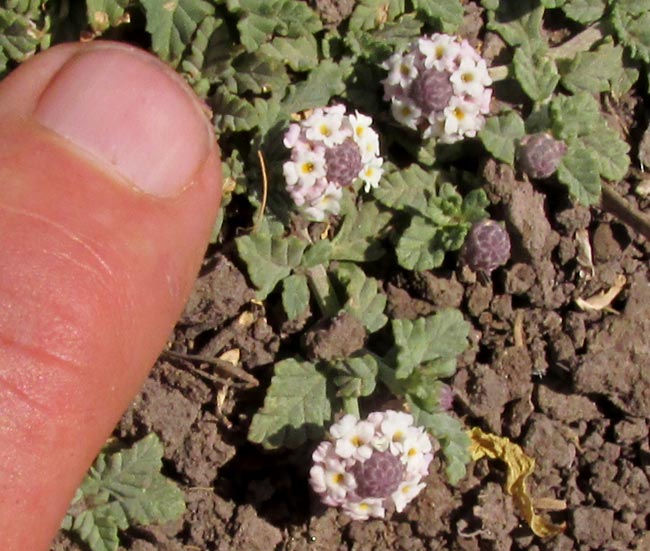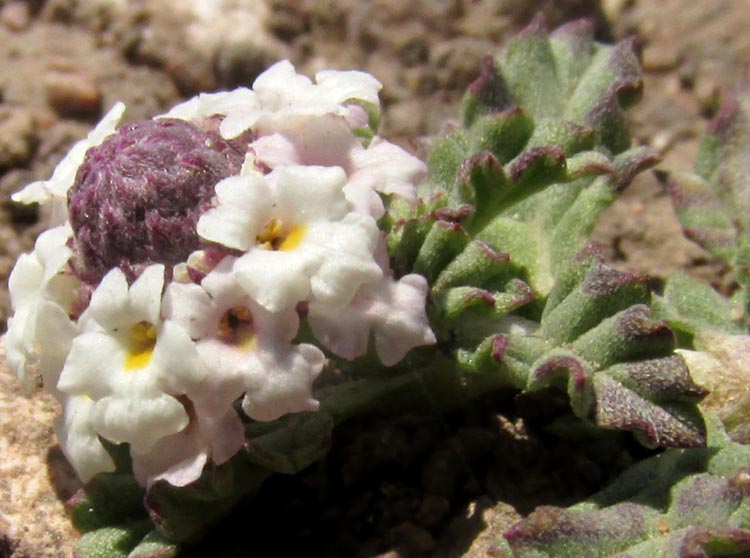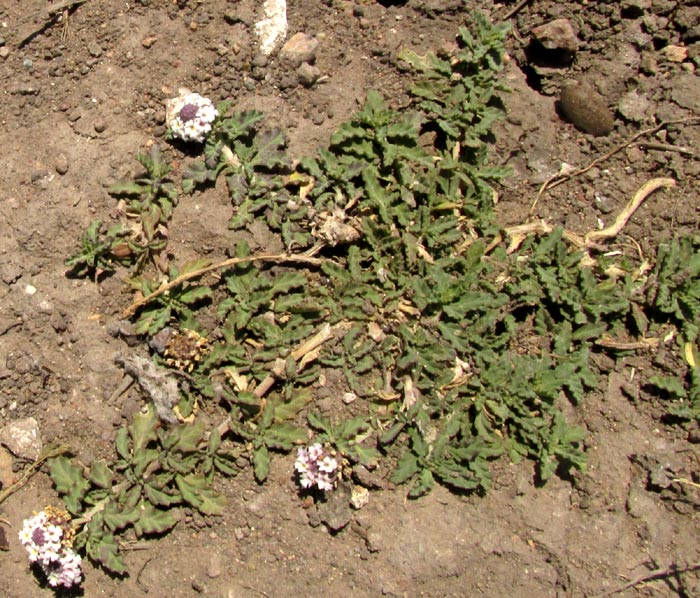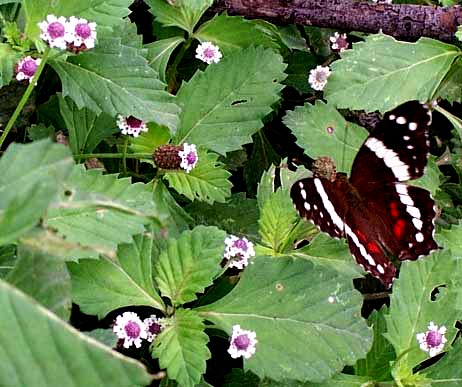Excerpts from Jim Conrad's
Naturalist Newsletter

Entry issued March 22, 2022, from near Tequisquiapan, elevation about 1,900m (6200 ft), ~N20.57°, ~ W99.89°, Querétaro state, MÉXICO
FROGFRUITS FLOWERING
Now as the dry really starts to bite, on the day the last puddle finally dried up completely in the village's little reservoir, I walked along the sunbaked edge looking for interesting plants. In a mudflat that most of the year stays submerged, where the mud was now hard-baked clay broken with long, snaky, deep cracks wide enough to poke your fingers into, I encountered what's shown above.
The compact little flowering heads of flowers with slightly asymmetrical, or zygomorphic, corollas with yellowish throats, the blossoms surrounding a low, purplish dome, are typical of the group of plants known up north as frog- or fogfruits. Below you can see the flowers better:

Later, the purplish dome will produce more flowers, a blossom from beneath each pointed scale. This arrangement is similar to what's seen with various lantana and lippia species, but in this baked-mud habitat and with these low, domed heads, thats the fog- or frogfruits. Another distinctive feature of our plant -- leafing and flowering sprouts arising from thick, almost woody stems trailing across the ground -- is shown below:

The taxonomy of the lantana/lippia/frogfruit part of the Verbena Family is in a general mess. Giving a scientific name, a binomial, in which you can be confident that everyone else will be in agreement, often is out of the question.
Now 2022 there's not even consensus among specialists whether frogfruit species belong to the genus Lippia or the genus Phyla. In North America I think the tendency is to assign the mostly herbaceous species, like ours, to the genus Phyla. Here in Mexico, most experts, not seeing a clear distinction between the two genera, lump them into the bigger genus Lippia. Using information in the Verbena Family treatment of the authoritative Flora del Bajío, our plant is identified as LIPPIA QUERETARENSIS, a species described as commonly, sometimes abundantly, occupying muddy or sometimes-muddy habitats from New Mexico and Texas in the north, all the way through Mexico south to Argentina.
Over the years, our plant has been given many scientific names. Our "Lippia queretarensis" can be viewed as a placeholder name, waiting for the day when somebody finally figures out what's what -- or else devises a new naming system accommodating population groupings in which the species merge into one another. The Flora del Bajío authors say that most botanical collections of our plant in Mexico have been labeled Lippia nodiflora.
Several sources report that traditionally our plant was used medicinally, though none I can find mention for what purpose.
from the May 5, 2007 Newsletter issued from Sierra Gorda Biosphere Reserve, QUERÉTARO, MÉXICO
FROGFRUITS, FOGFRUITS
As the dry season draws on the reservoir's water-level stands about 15 feet lower than when I arrived here. Certain spots that earlier lay submerged beneath shallow water now provide broad, grassy lawns for picnickers and campers, the grass kept short by burros and goats. In less frequented spots grass often is replaced by ankle-high tangles of the herbs shown below:

The flower heads in that picture are pea-sized, so the flowers themselves are tiny things. If you could look at an individual blossom with a good handlens you'd see that it's shaped like a little dog-head, like a verbena flower. In fact, the plant is a member of the Verbena Family. It belongs to the genus PHYLA, and probably is PHYLA FRUTICOSA {in 2022 still uncertain, see above entry}. In English, members of the genus Phyla are often referred to as Fogfruits or Frogfruits. Phylas are common throughout the US, except in the northwestern states. Of course in Australia our Phylas are invasive.
I'll bet there's an interesting story behind the plant's two names, fogfruit and frogfrut. I wouldn't be surprised if one of them came into being because of a typo committed long ago by someone preparing a flora manuscript. When I Google "fogfruit" I get 815 page-returns but when I look up "frogfruit" 2040 pages turn up, so "frogfruit" seems to be winning out.
I'm glad that "frogfruit" is winning if only because nowadays many of our frogfruit tangles shelter myriad tiny, immature toads. In places you can hardly take a step without smashing one. When you walk, sometimes the ground around your feet seems to ripple with hopping- away baby toads. Maybe "toadfruit" would be an even better name.